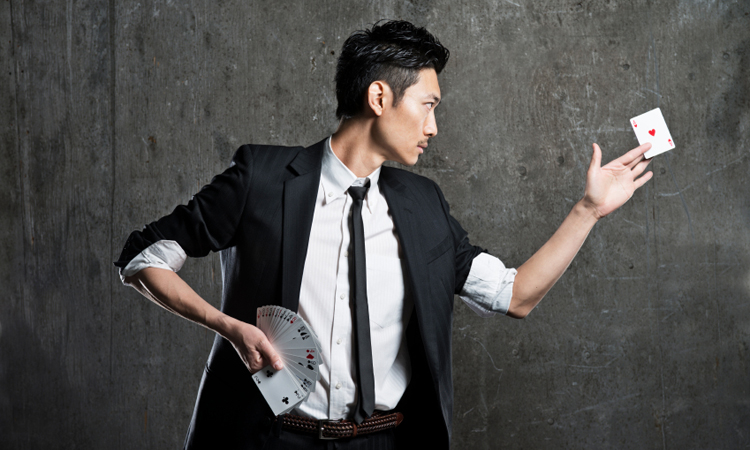
One of the most baffling things I ever saw as a child was a feat of magic by my older cousin Jeff. It started off as a standard card trick. I picked a random card from a normal deck and looked at it secretly. But instead of putting the card back into the deck as expected, Jeff tore it up and flushed the pieces down the toilet. Then he got an egg from the refrigerator and cracked it open into a bowl. In a surreal act of reincarnation, a miniature replica of the card I had picked came out with the raw egg.
Adhering to the magician’s code, Jeff wouldn’t tell me how he did the trick. I wonder about it to this day. But recently I found out that the success of his trick probably had as much to do with me as with Jeff’s skills of deception. I’ve learned that the design of the human brain makes it susceptible to magic tricks, and that this susceptibility is actually important to our survival.
Selective Perception Protects Us…and Fools Us
Every day, our senses are bombarded with stimuli. If we were to pay equal attention to every sight, sound, and smell that came our way, we would be overwhelmed and become pretty useless organisms. So we learn to be selective. We pay close attention to a snarling dog running at us, but don’t notice the pretty cardinal perched on a branch above the dog—even if the bird is front and center in our field of view.
We also make assumptions about things we perceive based on experience. When crossing the street, for example, we can tell by the distance a car is from us and how fast it’s going whether it’s safe to cross the street. Years of successful guesses in situations like this lock in a memory so we don’t have to review the situation every time before making a move.
In addition, our brains fill in gaps if we see only part of an image. Consider the case of the Kaniza square, shown below. We perceive a complete square, even though the image consists only of wedges cut out of circles. We see the square shape because it “should” be there, based on the sensory information provided.

Expectations and Assumptions Make Us See What Isn’t There
In the well-known “disappearing coin” trick, a magician appears to throw a coin from one hand and catch it with the other. Then he opens the receiving hand, and poof! The coin has miraculously vanished…and reappeared in the other hand. This trick is often performed by tossing a coin into the air a few times before throwing it into the other hand.
Viewers asked about this trick typically say that they see the coin flying through the air into the other hand. But this doesn’t happen—the coin never leaves the hand where it started. We’re fooled because our brain “fills in the blanks” when seeing the throwing motion. It looks like someone threw an object, so we perceive it as a real throw.
Observers tend to track the movements of the magician’s hand during the trick. Known as “smooth pursuit,” this tracking is a valuable asset for survival (it’s much more important to fix your attention on a stalking lion than on the surrounding scenery of the veldt). By isolating our attention to the most important target, we limit our ability to notice other things that may be happening right in front of us.
The impact of this selective attention is demonstrated by the behavior of neurons during the observation. When our eyes track something in motion, different types of neurons are activated. One type helps us detect the motion, while another type suppresses the background. This prioritizing helps explain why drivers suddenly have to slam on the brakes to avoid hitting something that may have been right in front of their eyes long before they were in danger of a collision. The driver may have been focused on something else, such as a song on the radio or an interesting bit of scenery, that momentarily became the main focus. I have often had a similar experience while looking for someone in a crowd at an airport or train station. I scan the faces looking for the familiar one, and then hear someone call my name. Right in front of me is the person I’ve been searching for. Part of the reason I didn’t see them sooner was because I didn’t expect the person to be so easy to spot; I had downgraded the easy, most accessible location to background status.
The natural limitations of our attention are made clear by the familiar inkblot image shown below. Some people see a black vase at the first viewing, while others see two white faces in profile facing each other. But you can’t see both images at the same time; focusing on one causes the other to recede into the background. A key part of the magician’s trickery is focusing our attention on irrelevant actions so that we don’t notice the sleight of hand.

A Little Distraction Goes a Long Way
False cues presented by the magician are often the key to an effective illusion, as demonstrated by the “disappearing” ball trick. In a study reported in Current Biology, observers watched a video of a magician who throws a ball up in the air and catches it a few times, then keeps the ball in his hand as he moves his arm upward as if throwing it again. Seeing is not believing: 63% of the observers reported seeing the ball leave the magician’s hand and then disappear, even though it didn’t leave his hand during the last throw. Tracking of the observers’ eye movements showed that they were paying more attention to the magician’s head direction than the ball itself. As the magician appeared to watch the ball move upward, the viewers synced up their perception with what they thought he was seeing. The impact of this distraction was confirmed by presenting another video of the trick in which the magician stared at his hand hiding the ball during the pretend final throw. In this version, only 32% reported seeing a ball being thrown.
Observers of tricks may think they are focusing completely on what the magician is doing, but they often aren’t. In a filmed sequence of magic performed by legendary faker-outers Penn and Teller, viewers were shown two different videos of a trick showing balls appearing and disappearing beneath cups. One version shows Teller’s entire body as he does the trick. The other version shows only his hands. In the hands-only version, observers were much more likely to see how the trick was done. We often glance at the magician’s face without knowing it, which gives a skilled performer like Teller enough of a window for deception.
So the next time you’re fooled by a magic trick, remember that your brain is programmed to be taken in. And your ability to be duped in this way is, for the most part, an important asset for daily living. As award-winning magician Alym Alani said, “Your brain has evolved over time to survive in the world. It hasn’t evolved to figure out magic tricks.”
The Phenomenon of Change Blindness
When an object we’re looking at is taken out of view, an image of the object remains in the brain. This phenomenon is known as “object permanence,” and it represents another useful survival tool. But it can also make us unaware of what should be immediately noticeable changes. Check out this card trick and get ready to be blindsided.
Click here to get inspired by Rose’s easy steps to positively change your mind
Post Disclaimer
This content is for informational purposes only and does not constitute medical advice. Please consult a healthcare professional for any medical concerns.


